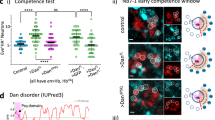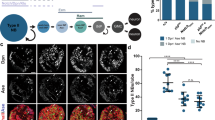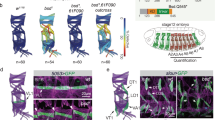Abstract
Asymmetric division of Drosophila neuroblasts (NBs) and the Caenorhabditis elegans zygote uses polarity cues provided by the Par proteins, as well as heterotrimeric G-protein-signalling that is activated by a receptor-independent mechanism mediated by GoLoco/GPR motif proteins1,2. Another key component of this non-canonical G-protein activation mechanism is a non-receptor guanine nucleotide-exchange factor (GEF) for Gα, RIC-8, which has recently been characterized in C. elegans and in mammals3,4,5,6. We show here that the Drosophila Ric-8 homologue is required for asymmetric division of both NBs and pI cells. Ric-8 is necessary for membrane targeting of Gαi, Pins and Gβ13F, presumably by regulating multiple Gα subunit(s). Ric-8 forms an in vivo complex with Gαi and interacts preferentially with GDP–Gαi, which is consistent with Ric-8 acting as a GEF for Gαi. Comparisons of the phenotypes of Gαi, Ric-8, Gβ13F single and Ric-8;Gβ13F double loss-of-function mutants indicate that, in NBs, Ric-8 positively regulates Gαi activity. In addition, Gβγ acts to restrict Gαi (and GoLoco proteins) to the apical cortex, where Gαi (and Pins) can mediate asymmetric spindle geometry.
This is a preview of subscription content, access via your institution
Access options
Subscribe to this journal
Receive 12 print issues and online access
$209.00 per year
only $17.42 per issue
Buy this article
- Purchase on SpringerLink
- Instant access to full article PDF
Prices may be subject to local taxes which are calculated during checkout





Similar content being viewed by others
References
Wodarz, A. & Huttner, W. B. Asymmetric cell division during neurogenesis in Drosophila and vertebrates. Mech. Dev. 120, 1297–1309 (2003).
Willard, F. S., Kimple, R. J. & Siderovski, D. P. Return of the GDI: the GoLoco motif in cell division. Annu. Rev. Biochem. 73, 925–951 (2004).
Colombo, K. et al. Translation of polarity cues into asymmetric spindle positioning in Caenorhabditis elegans embryos. Science 300, 1957–1961 (2003).
Afshar, K. et al. RIC-8 is required for GPR-1/2-dependent Gα function during asymmetric division of C. elegans embryos. Cell 119, 219–230 (2004).
Couwenbergs, C., Spilker, A. C. & Gotta, M. Control of embryonic spindle positioning and Gα activity by C. elegans RIC-8. Curr. Biol. 14, 1871–1876 (2004).
Tall, G. G., Krumins, A. M. & Gilman, A. G. Mammalian Ric-8A (synembryn) is a heterotrimeric Gα protein guanine nucleotide exchange factor. J. Biol. Chem. 278, 8356–8362 (2003).
Kaltschmidt, J. A., Davidson, C. M., Brown, N. H. & Brand, A. H. Rotation and asymmetry of the mitotic spindle direct asymmetric cell division in the developing central nervous system. Nature Cell Biol. 2, 7–12 (2000).
Cai, Y., Yu, F., Lin, S., Chia, W. & Yang, X. Apical complex genes control mitotic spindle geometry and relative size of daughter cells in Drosophila neuroblast and PI asymmetric divisions. Cell 112, 51–62 (2003).
Fuse, N., Hisata, K., Katzen, A. L. & Matsuzaki, F. Heterotrimeric G proteins regulate daughter cell size asymmetry in Drosophila neuroblast divisions. Curr. Biol. 13, 947–954 (2003).
Yu, F., Cai, Y., Kaushik, R., Yang, X. & Chia, W. Distinct roles of Gαi and Gβ13F subunits of the heterotrimeric G protein complex in the mediation of Drosophila neuroblast asymmetric divisions. J. Cell Biol. 162, 623–633 (2003).
Bardin, A. J., Le Borgne, R. & Schweisguth, F. Asymmetric localization and function of cell-fate determinants: a fly's view. Curr. Opin. Neurobiol. 14, 6–14 (2004).
Cismowski, M. J., Takesono, A., Bernard, M. L., Duzic, E. & Lanier, S. M. Receptor-independent activators of heterotrimeric G-proteins. Life Sci. 68, 2301–2308 (2001).
Kaltschmidt, J. A. & Brand, A. H. Asymmetric cell division: microtubule dynamics and spindle asymmetry. J. Cell Sci. 115, 2257–2264 (2002).
Knust, E. G protein signaling and asymmetric cell division. Cell 107, 125–128 (2001).
Doe, C. Q. & Bowerman, B. Asymmetric cell division: fly neuroblast meets worm zygote. Curr. Opin. Cell Biol. 13, 68–75 (2001).
Jan, Y. N. & Jan, L. Y. Asymmetric cell division in the Drosophila nervous system. Nature Rev. Neurosci. 2, 772–779 (2001).
Matsuzaki, F. Asymmetric division of Drosophila neural stem cells: a basis for neural diversity. Curr. Opin. Neurobiol. 10, 38–44 (2000).
Bellaiche, Y. et al. The Partner of Inscuteable/Discs-large complex is required to establish planar polarity during asymmetric cell division in Drosophila. Cell 106, 355–366 (2001).
Kimple, R. J., Kimple, M. E., Betts, L., Sondek, J. & Siderovski, D. P. Structural determinants for GoLoco-induced inhibition of nucleotide release by Gα subunits. Nature 416, 878–881 (2002).
Izumi, Y., Ohta, N., Itoh-Furuya, A., Fuse, N. & Matsuzaki, F. Differential functions of G protein and Baz-aPKC signaling pathways in Drosophila neuroblast asymmetric division. J. Cell Biol. 164, 729–738 (2004).
Gotta, M. & Ahringer, J. Distinct roles for Gα and Gβγ in regulating spindle position and orientation in Caenorhabditis elegans embryos. Nature Cell Biol. 3, 297–300 (2001).
Srinivasan, D. G., Fisk, R. M., Xu, H. & van den Heuvel, S. A complex of LIN-5 and GPR proteins regulates G protein signaling and spindle function in C. elegans. Genes Dev. 17, 1225–1239 (2003).
Tsou, M. F., Hayashi, A. & Rose, L. S. LET-99 opposes Gα/GPR signaling to generate asymmetry for spindle positioning in response to PAR and MES-1/SRC-1 signaling. Development 130, 5717–5730 (2003).
Hess, H. A., Roper, J. C., Grill, S. W. & Koelle, M. R. RGS-7 completes a receptor-independent heterotrimeric G protein cycle to asymmetrically regulate mitotic spindle positioning in C. elegans. Cell 119, 209–218 (2004).
Schaefer, M., Petronczki, M., Dorner, D., Forte, M. & Knoblich, J. A. Heterotrimeric G proteins direct two modes of asymmetric cell division in the Drosophila nervous system. Cell 107, 183–194 (2001).
Bellen, H. J. et al. The BDGP gene disruption project: single transposon insertions associated with 40% of Drosophila genes. Genetics 167, 761–781 (2004).
Takida, S. & Wedegaertner, P. B. Heterotrimer formation, together with isoprenylation, is required for plasma membrane targeting of Gβγ. J. Biol. Chem. 278, 17284–17290 (2003).
Yu, F., Morin, X., Cai, Y., Yang, X. & Chia, W. Analysis of partner of inscuteable, a novel player of Drosophila asymmetric divisions, reveals two distinct steps in inscuteable apical localization. Cell 100, 399–409 (2000).
Gho, M. & Schweisguth, F. Frizzled signalling controls orientation of asymmetric sense organ precursor cell divisions in Drosophila. Nature 393, 178–181 (1998).
Acknowledgements
We thank H. Bellen, C.Q. Doe, D. Glover, Y.N. Jan, D. St Johnston, T. Kaufman, C. Klambt, J.A. Knoblich, E. Knust, F. Matsuzaki, S. Roth, F. Schweisguth, X. Yang, A. Wodarz, Developmental Studies Hybridoma Bank (University of Iowa) and the Bloomington Stock Center for generously providing antibodies and fly stocks. We thank F. S. Willard for discussion and support, and W. Chia thanks Y. Cai for stimulating discussions. This work was supported by Temasek Life Sciences Laboratory, Singapore Millennium Foundation (F. Y.) and Wellcome Trust (W. C.).
Author information
Authors and Affiliations
Corresponding authors
Ethics declarations
Competing interests
The authors declare no competing financial interests.
Supplementary information
Supplementary Information
Supplementary figure S1, S2, S3 and S4 (PDF 580 kb)
Rights and permissions
About this article
Cite this article
Wang, H., Ng, K., Qian, H. et al. Ric-8 controls Drosophila neural progenitor asymmetric division by regulating heterotrimeric G proteins. Nat Cell Biol 7, 1091–1098 (2005). https://doi.org/10.1038/ncb1317
Received:
Accepted:
Published:
Issue Date:
DOI: https://doi.org/10.1038/ncb1317



